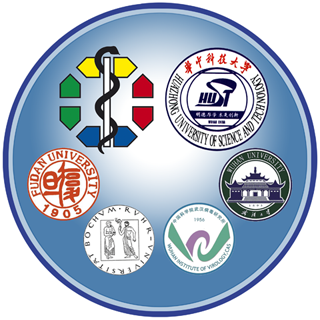About us

"Health related, life entrusted " - the oath of Chinese medical students
Huazhong University, Campus of Tongji Medical School, Wuhan
Scientific Rationale of the Transregio
The WHO estimates that almost 500 million people world-wide are chronically infected with HBV, HCV or HIV. China and Europe share a similar burden of infection with HIV and HCV but despite prophylactic vaccination, HBV continues to be a major health problem in China. The three viruses are transmitted similarly (blood products and sexual transmission), and vaccination against HIV and HCV has not been possible until now. A complicating problem for patients is that co-infections with two or even three different viruses have become a more frequent phenomenon. Interestingly, there are substantial differences in the rate of viral persistence after infection with the three viruses. Whereas it is virtually 100% for HIV, it is up to 80% for HCV, and less than 10% for HBV.
Thus, there are obvious differences in the mechanisms that lead to the establishment of chronicity by these viruses. One aim of the Transregio is to compare these differences in animal models and infected patients, as it might give new clues on how viral chronicity might be prevented. All viruses have to evade the innate and the adaptive immune system to become chronic. Hence, within the scientific Transregio network, these mechanisms will be intensively studied in cell culture, animal models, and patients.
It is generally accepted that once persistent infection is established some common features of the interaction of different viruses with the immune system apply. Theses common mechanisms, e.g. T cell exhaustion, mutational escape, regulatory T cell suppression, will also be a main area of research of the Transregio projects.
One other common factor is that all three chronic infections are difficult to treat. Current options for therapy are interferon alpha (HCV and HBV) and specific inhibitors of viral enzymes. However, these treatments are far from being optimal because of high therapy costs, severe side effects, and increasing problems with drug resistance mutations. Therefore, there is still an urgent need to better define the mechanisms of establishment of viral chronicity in HIV, HBV and HCV infection and to use this knowledge for developing new therapeutic strategies.
The most efficient means to prevent acute and subsequent chronic infection would be a safe and effective vaccine. Unfortunately, a prophylactic vaccine has only been established for HBV but after many years of research no vaccines against HCV or HIV exist. Thus, more basic research for the development of an HCV and HIV vaccine, which is part of the Transregio programme, should be performed.
For defining new strategies in vaccine development, it will also be important to better understand the factors that play a role in the transition from acute to persistent viral infections. Most of these factors should be related to the immune system of the infected host. Cells and molecules of the innate and adaptive immune system are able to fight most viruses and thus prevent severe acute diseases or chronic infection. This is orchestrated by semi-specific as well as highly specific recognition of the pathogen followed by an efficient elimination of free virus or virus-infected cells. The cell types and molecules involved in this process, demonstrating the importance of the system for the survival of the host are numerous. However, viruses that establish chronic infections have developed several different mechanisms to inhibit anti-viral functions of immune cells or their anti-viral molecules. As a result, viral replication can no longer be controlled and persistent infection is established. In the Transregio we are defining basic mechanisms of viral immunity and immune escape by viruses. The objective is to gain a fundamental understanding of the mutual interaction of chronic viruses with cells of the immune system and then to use this knowledge for developing new strategies of immunotherapy and vaccination.
根据WHO的最新资料估计,全世界约5亿人受到HBV、HCV和HIV慢性感染。中国和欧洲HIV和HCV的感染状况大致相当。尽管乙肝疫苗的应用获得了很大成功,在中国HBV感染仍是一个严重的健康问题。而对于HCV和HIV感染,迄今尚缺乏有效的疫苗。目前上述三种病毒中两种甚至三种不同病毒的共感染患者日益多见,成为临床治疗的难点。HBV、HCV和HIV有着类似的传播途径(血源性传播和性传播),但这三种病毒感染后导致病毒持续感染的机率却明显不同,其中HIV感染后的慢性化机率为100%,而HCV感染为80%左右,HBV感染后形成慢性化的机率则与感染年龄有关,围产期感染慢性化机率约80%,而成人感染则仅有不到20%的机率发展为持续性感染。因此,比较HBV、HCV和HIV持续感染形成过程的差异显得非常重要,因为这将为防治病毒感染的慢性化提供新的可能策略。尽管不同的病毒之间千差万别,但是所有病毒感染要发展成为持续感染,必须逃避机体天然免疫和获得性免疫系统的识别与攻击。在这个过程中,病毒与免疫系统相互作用的机制则基本类似。HBV、HCV和HIV感染的共同点之一是它们都难以治愈。现有的可供选择的治疗药物包括α-干扰素(HBV和HCV)和病毒蛋白酶的特异性抑制剂,如核苷(酸)类似物药物。然而,高昂的治疗费用、严重的并发症和日益增加的耐药突变问题使得这些治疗措施远未能达到理想的治疗效果,因此,继续研发新药物、新方案和新的治疗策略是该领域亟待解决的重大科学问题。 预防慢性病毒感染最有效的方法当属安全有效的疫苗,随着HBV的预防性疫苗进入国家计划免疫行列,已经取得了巨大的成绩。因此,开发HCV和HIV预防性疫苗的研究还需继续,这也是本项目的重要研究内容。研发有效的疫苗必须建立在进一步了解病毒感染过程中病毒与宿主细胞,尤其是与免疫细胞的相互作用机制以及从急性感染转为慢性感染的影响因素基础之上,这些因素可能大部分与被感染者的免疫系统有关。其中,天然性和适应性免疫细胞及其相关分子能够有效抵抗大多数病毒的感染,防止严重的急性感染或慢性感染的发生。这些免疫细胞通过对病原体的泛特异性和特异性识别,实现对游离病毒或病毒感染细胞的有效地清除。参与上述过程的细胞类型和分子数量众多,证明免疫系统对于宿主的生存非常重要。然而,可导致慢性感染的病毒能够通过许多不同的机制来抑制免疫细胞的抗病毒功能及其产生的抗病毒分子,从而导致病毒的复制不再受控制,进而发展为持续感染。治疗性疫苗的目标,则是在患者体内重新建立起具有抗病毒能力的免疫细胞,打破病毒与免疫系统间的耐受状态,从而清除病毒。在本项目中,我们将利用体外细胞培养系统、动物模型和患者样本,围绕抗病毒免疫和病毒的免疫逃逸等基础科学问题,研究慢性病毒感染与免疫细胞相互作用的分子和细胞机制,为慢性病毒感染的预防性和治疗性疫苗的研发奠定实验和理论基础。


